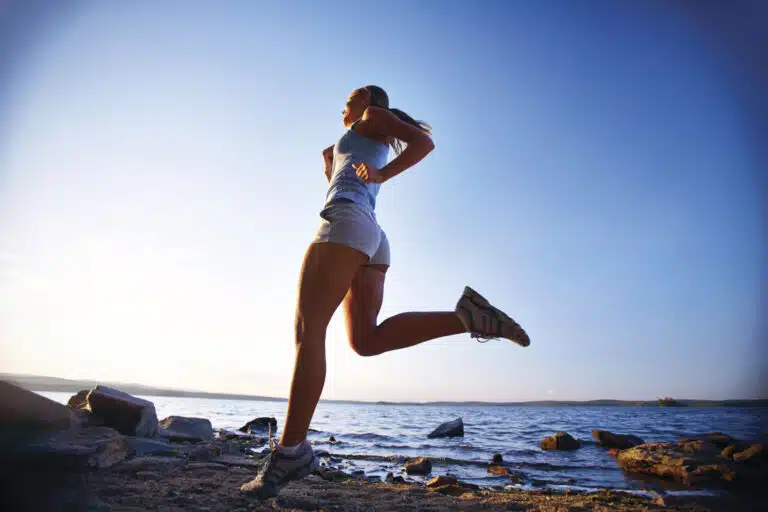PHYSICAL HEALTH
Movement – the natural endorphin HIGH

WORDS: Rick Brennan PHOTOGRAPHY Supplied
As the old saying goes, ‘move it or lose it’. Recent studies show movement has an enormous impact on the psychology as well the physiology of the human body.
MOVEMENT for all of us means so many different things and for some, the word movement can strike fear of the unknown activity it entails. Movement is an essential part of life but for some people, this is a luxury they simply don’t have for one reason or another and is something a lot of us take for granted. Once it is taken away, we unfortunately, realise the positive impact it can have for us and the many emotions it can trigger. As the old saying goes “move it or lose it”.
Recent studies show movement has an enormous impact on psychology as well as the physiology of the human body. Yes, movement impacts the brain and body. Notice I keep repeating the word movement without mentioning exercise, as many movements go unvalidated as exercise, but we can get similar responses, particularly for the brain, from just raising our heart rate from moving in different planes.
The past few years have been increasingly stressful for everyone with the ever-changing worldwide health landscape but for some, this has brought a newfound form of stress relief in exercise.
In this edition, I want to outline some of the many positive impacts that movement creates while also giving my recommendations for what I believe the best forms of exercise and training are and why.
In times of stress, at some point in our lives, there has likely been someone saying ‘go for a walk and clear your head’. Well, this is due to the production of BDNF (Brain-Derived Neurotrophic Factor) which aids in mental clarity, offering a far clearer mind to make well-judged rational decisions. BDNF is a specific protein that protects brain cells and promotes new, healthier brain cells, which leads to improved brain function. Movement has been shown to positively spike BDNF levels, hence the reason I encourage everyone to move more throughout the day regardless of their occupation or lifestyle.
There is no better time to go for a walk than first thing in the morning, which allows you the time to plan and think with a clear mind about the direction you want your day to take. It allows you to be present in the now. I encourage everyone at all opportunities to walk outdoors for several reasons. One is when sunlight enters our eyes, research shows our entire brain lights up. This process is known as ‘photobiomodulation’, where the body uses sunlight to help reduce aches, pains and inflammation while also repairing cells and tissues. The morning sun (before 10 am) also has enormous impacts on our inner body clocks and circadian rhythm. Our body makes melatonin at the start of each day, which enables us to regulate and maximise our sleep cycles. So many of us endure poor and interrupted sleep patterns and yet if we can only make some time for ourselves to get some morning sunlight, the improvements can be profound. Another very important aspect for getting outdoors is vitamin D, which is critical for optimising health and considering around 90 per cent of the body’s vitamin D is produced from the sunlight hitting our skin. It has become alarmingly clear most of us are deficient in vitamin D and one major cause is we don’t get enough sunlight.
While any movement is better than none, I believe it’s important to recognise our goals and what we enjoy to make any exercise program sustainable. To look like a runner we must run, to look like a boxer we must box and to change our body shape (aesthetics) we must strength train.
Any style of exercise can aid in stress management as it increases blood flow while optimising the body’s use of oxygen and at the same time, releasing endorphins – the feel-good hormones. For those who run, they refer to this being the runner’s high. Activities such as running, cycling and swimming have a greater need for oxygen to convert carbs or fat to energy to power the activity. This is better known as aerobic exercise. High aerobic activities such as running, cycling and swimming no doubt can strengthen muscles, improve stability, balance and coordination and increase flexibility but fall short in some ways to what I believe strength resistance training can achieve.
Muscle is no doubt the organ of longevity and as we age it’s increasingly harder to maintain muscle, let alone grow new muscle, therefore it’s vitally important we sustain some type of resistance training throughout our lives. There are four ways our body will burn calories throughout the day, with the largest calorie expenditure coming from BMR (Basal Metabolic Rate). BMR is shown to burn up to 60 to 70 per cent of our daily calories, which our body uses to maintain vital functions such as breathing, cell production, nutrient processing, heart rate and brain function. What surprises most people is the number of calories EAT (Exercise Activity Thermogenesis) contributes to the average person. Most studies show at best between five to 10 per cent of calories are burnt from exercise activities, with the remaining calories burnt from NEAT (Non-Exercise Activity Thermogenesis – walking around, fidgeting, getting up from chairs etc) 10 to 15 per cent. TEF (Thermic Effect from Food), calories burnt through digestion and absorbing the nutrients from the food we eat, equates to 10 per cent.
Strength training is the key to growing muscle but more importantly for most is maintaining that hard-earned muscle. Muscle has the biggest impact on our BMR. A common trend these days is for anyone exercising to wear a calorie tracking watch, which I recommend as it’s a great tool to track our steps, activity and sleep patterns. An aspect many people are misguided with is the calories burnt during high output cardio activity such as running or riding. Yes, you will normally burn far greater calories during these cardio sessions compared to a strength session however most people don’t realise once that activity is over, our activity thermostat basically stops whereas, with strength training, the calories continue to burn for many hours after the session is complete. One reason is EPOC (Excess Post-exercise Oxygen Consumption), better known as the afterburn, but I feel the real benefits come from building or maintaining lean muscle mass, which has an enormous impact on BMR. I like to refer to my clients as burning calories manually (running or another form of high cardio output exercise) or automatically burning calories from the building of more lean muscle mass.
Strength training increases both anaerobic and aerobic energy expenditures while having the same beneficial impacts to improved heart health as other cardio activities. Strength training has been shown to benefit cognitive performance, with links to the protection from degeneration of the hippocampus. This complex brain structure is found deep in the temporal lobe and plays a key role in learning and memory.
A key benefit from resistance (strength) training, I believe, is the body’s ability through trained muscles to increase the capacity to store blood glucose in the form of glycogen. This plays a key role in lowering blood glucose levels and creating a more insulin-sensitive environment. Diabetes is now a major cause of death around the world, with a 70 per cent increase in the past 20 years. A combination of controlled diet and regular strength training can greatly reduce our chances of ever dealing with this terrible disease that kills more than 10 per cent of Australians each year, with another one million admitted to hospital. Exercising has been shown to lower your blood sugar levels for up to 24 hours after training, creating a far greater insulin-sensitive environment and allowing the easy uptake of carbs to be stored in our muscles.
I refer to our muscles as our fuel tanks. The more muscle we hold, the bigger our fuel tanks. The more often we train, the faster we empty our fuel tanks, allowing us to eat more carbohydrates. I always encourage people to earn their carbs throughout the day. The more we utilise for energy, the more we can enjoy eating.
I understand we all live in a time-poor age with endless tasks from the moment we wake to the moment our heads hit the pillow. Health is true wealth but for some, they only realise it when circumstances change and the freedom to exercise is taken away. I encourage everyone to find the time for at least three 30-minute sessions a week of strength training or four 30-minute sessions a week of cardio activity.
Value your health. It’s one of our greatest assets. I encourage everyone to make some positive steps – in most cases, slight changes to enable greater health and happiness for yourself and for the people who mean the most to you.
* Rick Brennan is a certified personal trainer, strength and conditioning coach and sports nutritionist with more than 25 years’ experience in the health and fitness industry. Rick has helped change the lives of thousands of people through his body transformation coaching and online personal training and nutrition programs.
Email [email protected] or visit www.rickbrennan.com.au to find out more.








